Isn't it funny how life pans out?
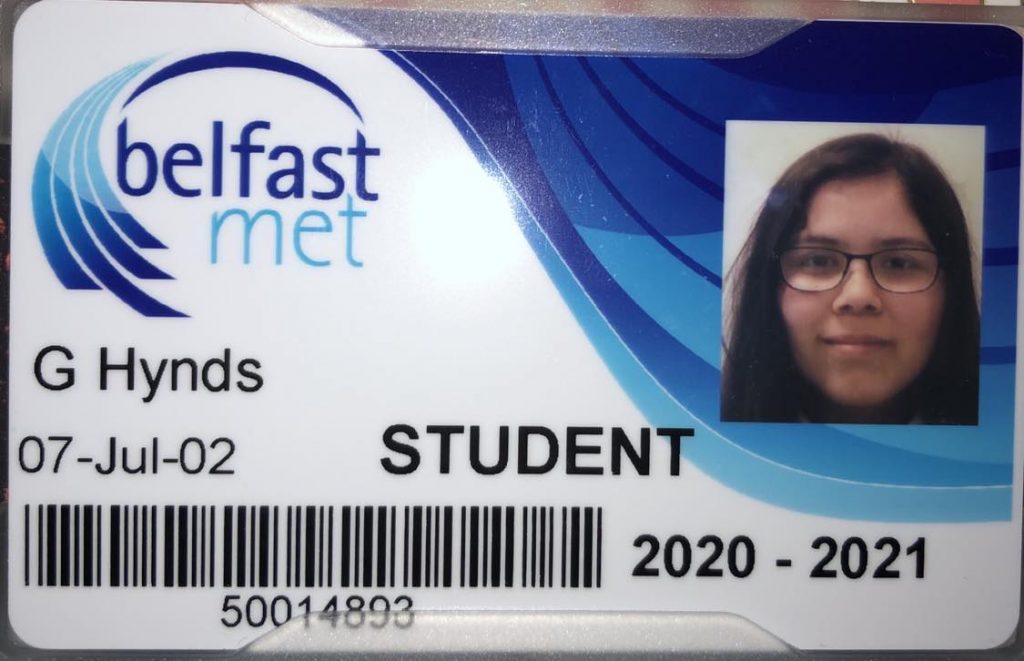
Allow me to illustrate a scene for you.
It is an unpleasantly frosty afternoon on 6th February 2020, Belfast. The headlines say the new flu-like virus has, to nobody’s delight, arrived in Northern Ireland. How strange. A 17-year old Grace suddenly remembers that she’s in class for Film Studies, and swiftly slides her phone back into her pocket. She’s meant to be concentrating. And yet, she still loses her grip on the present reality and stares off into the distance, wondering if it’s even worthwhile filling out a lengthy UCAS application for that university.
On 17th October 2023, a 21-year old Grace stares at the faces of sleep-deprived students who are now sat at the table where she once was – it’s their territory now. And they’re staring back at her, with anticipation.
If you haven’t caught on already, I am Grace. And at this very moment, I am about to deliver my very first lecture as a classroom assistant at Belfast Metropolitan College – the place I called home four years prior.
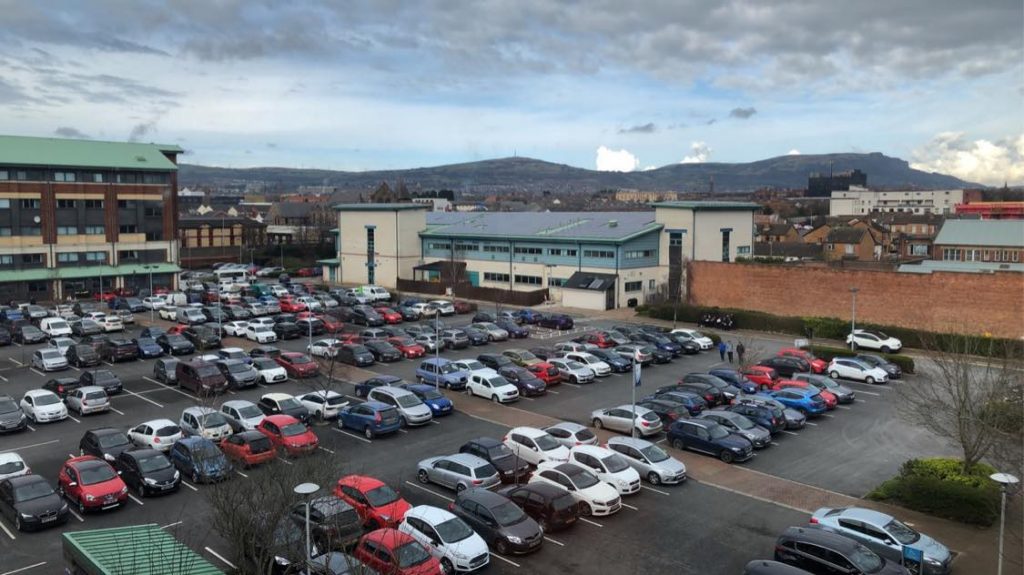
A Self-inflicted Case of Déjà Vu
Let’s look at how I got here.
It was never my intention to re-enter the sliding doors of my old college campus.
When I received my acceptance letter for Queen’s University, my heart sang. “I’m going to be a Broadcast Production student!” I exclaimed. “This means I can actually take my work placement at the BBC!” I exclaimed, again. Clearly, that didn’t happen – and it was my choice.
Why did I decide to retrace my steps when I could have been rubbing elbows with the biggest names in the local media industry? Did I really miss those soggy gravy chips that badly? Or the musty, sardine-can elevators?
Of course not.
Utilising Gibbs’ cycle of self-reflection (McMillan 33), I will tell you the tale of how I wound up back where I began, harnessing my catalogue of academic skills from University and gaining new perspectives as I navigate the waters of Further Education and lecturing in media.
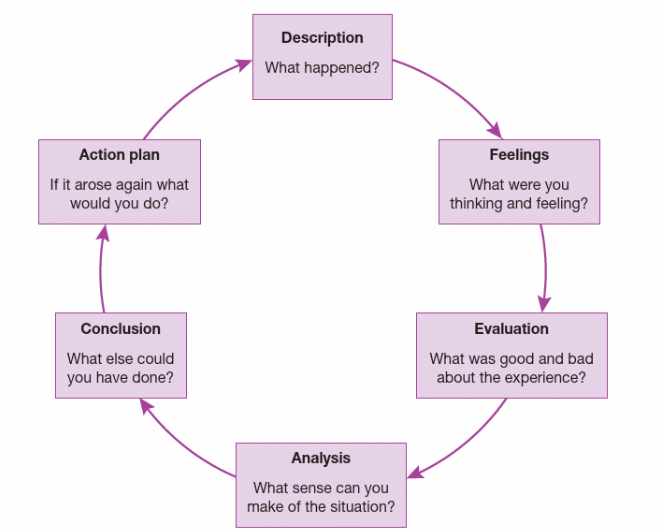
Description
Writing and communication have always been my two strongest abilities. In group media productions, I was the person who drew up forms, answered emails, interviewed contributors over telephone, offering reassurance. If my classmates had an issue with the terminology used in an assignment brief, they would turn to me. They would send me drafts of their PowerPoint slides, essay plans, seminar notes. I didn’t mind. I liked being the nerd.
But eventually, I began to wonder: shouldn’t I put these peculiarities of mine to good use?
I had always admired my former lecturer Craig. We kept in touch over the years after I began studying at Queen’s. He had been promoted to a full-time lecturer on the course that got me into university: the BTEC Level 3 Extended Diploma in Creative Media Production. A lot of waffle, I know.
Despite my lack of experience in teaching, I reached out to Craig and enquired about arranging a work placement as a Classroom Assistant. The position would give me the opportunity to put my skills in research, writing, and communication to active use. Furthermore, it would challenge me in an expertise I had yet to properly practice – public speaking.
After an exchange of forms and a few weeks, I had officially secured the placement I yearned for. My duties were outlined to me: assist in the delivery of coursework, answer student queries, and most notably, present a series of guest lectures. It was time to take the leap of faith – I was going to become the teacher I wanted for myself all those years ago.
Feelings
One participant in Walker’s reflective portfolio expressed, ‘Write it as it is, not as you would like it to be, nor as you think it should be’ (77). Adhering to that statement, I shall be be truthful: I had absolutely no idea what I was doing. I stumbled, notepad in hand, into the familiar classroom filled with unfamiliar teenagers, ready to take notes and spout off a series of intelligent and productive one-liners. Except, I didn’t, and I felt like a wallflower. After that first day, I seriously thought I was in way over my head. How was I going to deliver a world-class presentation when I can’t even speak up?
I tried to shake off the doubt by reminding myself why I was really there. Those students my inner voice wanted me to fear? I was one of them not too long ago. We shared the same anxieties. When you’re attending a technical college, nobody perceives you as a ‘real’ candidate for higher education. I didn’t have to ask Craig for evidence to know that these students were talented. They were more than capable of becoming expert media practitioners and film school graduates.
The bridge between the student and their potential future career or degree was proper support and non-judgemental understanding. I was the bridge.
I began devising the first of a series of presentations for the students – the TV and Film Starter Pack. In conjunction with upcoming UCAS deadlines, I decided my first lecture would focus on Higher Education and University. Before anything else, I knew that…
‘For communication to be effective, the content needs to be clearly understood, meaningful and interesting to the audience.‘
(Chivers and Shoolbred, 25)
Evaluation

Though I had my phases of self doubt, I thoroughly enjoyed crafting my presentation. I started off with the concept of making the material aesthetically pleasing and trendy for my audience of young adults. Next, the content had to be easily digestible – I made use of both bullet points, colourful images, and pie charts to display the information. Every other day, I would forward my progress over to Craig to ensure that my work was suitable, or if it required any adjustments. The PowerPoint, as I have been told, was a success. I am happy to continue with my ‘starter pack’ concept.
Scripting my presentation notes was tough enough as I wanted my voice to be friendly rather than condescending. However, it was the delivery of the presentation that was the most challenging. I had played off any worries I had as ‘overthinking’, but minutes before I was due, I was trembling. Admittedly, I had only rehearsed the entire lecture once, which became apparent with a few minor mishaps I made – fumbling with the interactive whiteboard, messing up a sentence, the usual. To my relief, the class applauded me for the lesson, and I allowed myself to feel proud of my accomplishment. Later, and with a clearer head, I could investigate my areas for improvement through my feedback form.
Analysis
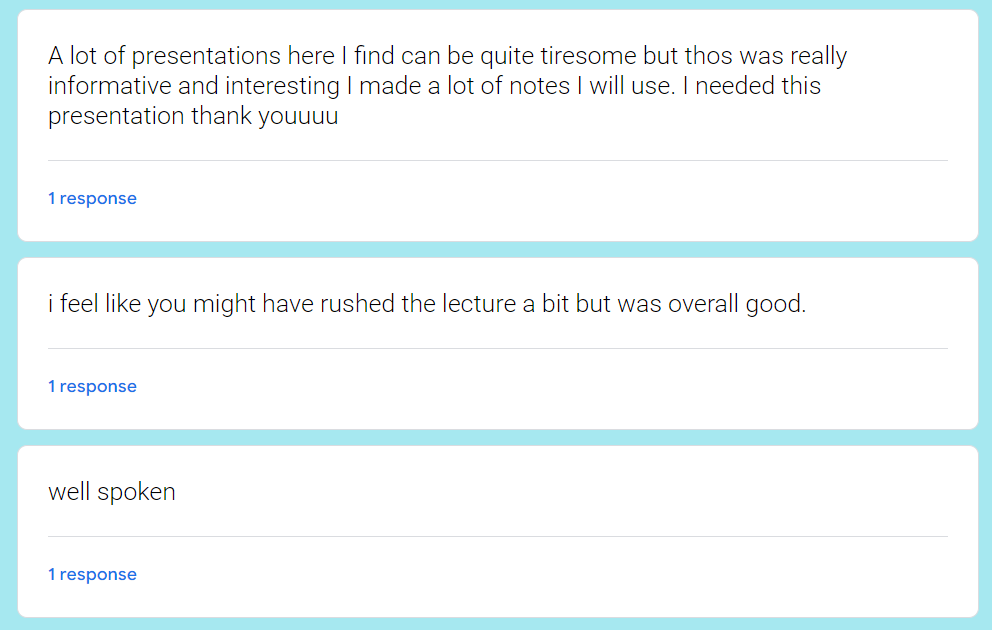
Before my presentation, I knew that there were two things I needed to fuel my progress and improvements moving forward: a debrief with my placement supervisor Craig, and honest feedback from my students.
According to Walker, ‘in any planned activity for learning, debriefing provides an opportunity to engage in [this] reflection’ (69). I had my own thoughts about my performance, but I needed to discuss it with somebody who was trustworthy and experienced in this area. Craig was pleased with my work, specifically noting that the contents of my presentation were a highlight and appealing to the students. He suggested that I provide him with a copy of the slides as referential material for the students in the future – this indicated to me that my slides were quite content-heavy, a quality which has positives and negatives.
My assumptions were reflected in the responses to the feedback form I had prepared for the students. The reception was overall positive, with a few commenting that the material was ‘helpful’. Others responded that they enjoyed the presentation, though I could have been better-paced and less rushed. Where do we go from here?
Conclusion
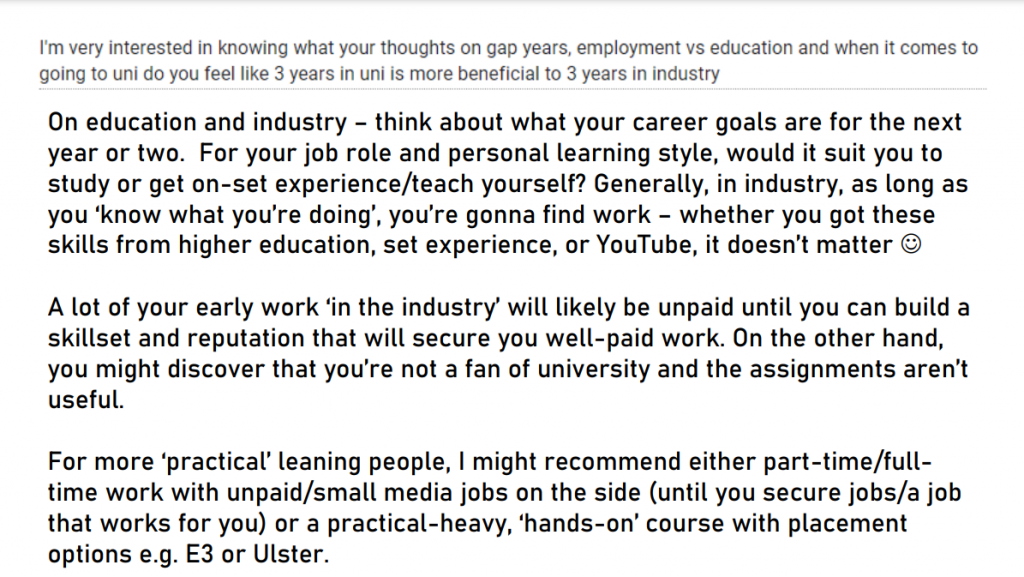
My primary flaw, upon reflection, stemmed from the amount of content presented – it did not align with the speed of my delivery. There are multiple methods of avoiding this issue in future presentations, and I have settled on rehearsing my public speaking skills ahead of my next lecture. I came to this conclusion by taking into consideration my strengths and positive comments alongside my weaknesses and mistakes. My underdeveloped skills in public speech are the root cause of my poor pacing and lack of confidence, therefore I will dedicate more time to working on this so that my future lectures are less ‘rushed’.
Additionally, I will take on board suggestions from my placement supervisor and colleagues, such as incorporating elements of ‘interactive learning’. Examples include a ‘question time’ session, quizzes, and inclusion of video content.
My own self reflection, combined with student feedback and advice from my placement supervisor should support my journey into becoming a well-rounded classroom assistant.
Action Plan
As I write this final section, it has nearly come time for my next presentation. Utilising my feedback form, I allowed the class to suggest the next topic. On this occasion, they have chosen Cinematography and Cameras. With my self reflection and personal lack of experience in cinematography in mind, my plan of action was to make this lecture both interactive and knowledgeable. I have decided to collaborate with my fellow Belfast Metropolitan College alumni and industry professional Luke Galbraith for this lecture. I will continue to play to my strengths in writing, creating enriching lesson material whilst making progress on my own presenting abilities. In response to the feedback and advice, I will incorporate a ‘Question Time’ segment with special (second!) guest Luke Galbraith, an exciting opportunity for the students to interact and gain practical knowledge from a working cinematographer.
In following presentations, I will begin to explore other interactive modes of learning in conjunction with my detailed slides. I’m currently thinking of a Christmas quiz to end the academic year – if I’m feeling generous, perhaps there will even be a prize?
Works Cited
Chivers, B. and Michael Shoolbred. A student’s guide to presentations: making your presentation count. SAGE Publications, 2007.
McMillan, Kathleen. How to Improve your Critical Thinking & Reflective Skills, Pearson Education UK, 2013.
Walker, David. “Writing and Reflection”. Reflection: Turning Experience into Learning, edited by David Boud, et al., Taylor & Francis Group, 1985.